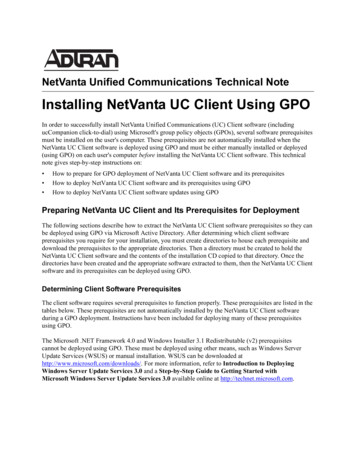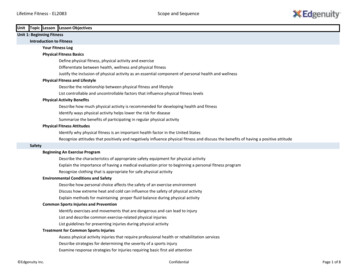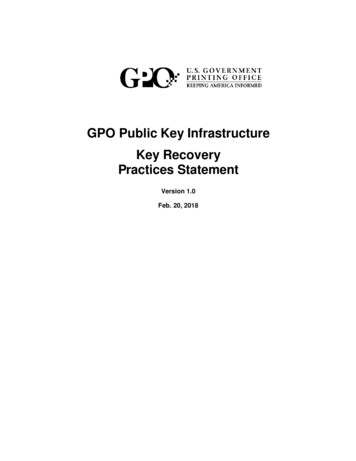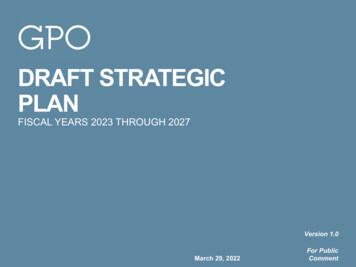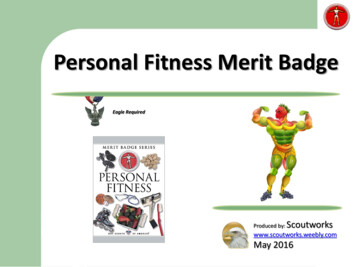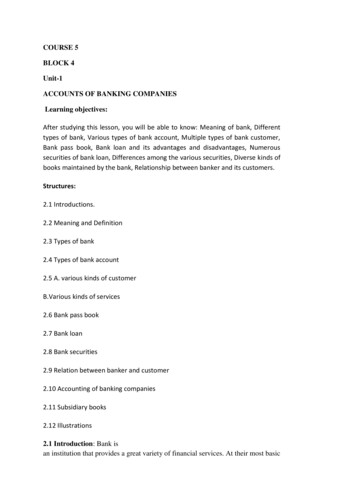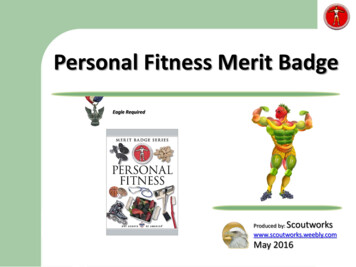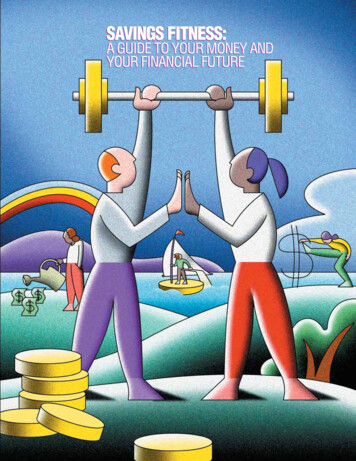
Transcription
SAVINGS FITNESS:A GUIDE TO YOUR MONEY ANDYOUR FINANCIAL FUTURE
This publication has been printed by the U.S. Department of Labor,Employee Benefits Security Administration (EBSA), and is available on theWeb at www.dol.gov/ebsa.For a complete list of EBSA publications visit the agency’s website at www.dol.gov/ebsa.To order publications or to speak with a benefits advisor, contact EBSAelectronically at www.askebsa.dol.gov or call toll free 1-866-444-3272.This material will be made available in alternative format to personswith disabilities upon request:Voice phone: 202-693-8664 TTY: 202-501-3911Certified Financial Planner Board of Standards Inc. (CFP Board) is a partner in thepreparation of this publication. CFP Board owns the certification marks CFP , CERTIFIEDFINANCIAL PLANNER andin the U.S. , which it awards to individuals whosuccessfully complete initial and ongoing certification requirements. Visit CFP Board’s website,www.LetsMakeAPlan.org, for information about financial planning and to find a financialplanner who fits your needs and who will put your needs first.This booklet constitutes a small entity compliance guide for purposes of the Small Business RegulatoryEnforcement Act of 1996
Content HighlightsA FINANCIAL WARMUP3YOUR SAVINGS FITNESS DREAM5HOW’S YOUR FINANCIAL FITNESS?7AVOIDING FINANCIAL SETBACKS9BOOST YOUR FINANCIAL PERFORMANCE11STRENGTHENING YOUR FITNESS PLAN13PERSONAL FINANCIAL FITNESS15MAXIMIZING YOUR WORKOUT POTENTIAL17EMPLOYER FITNESS PROGRAM19FINANCIAL FITNESS FOR THE SELF-EMPLOYED21STAYING ON TRACK23A LIFETIME OF FINANCIAL GROWTH25A WORKOUT WORTH DOING27RESOURCES29WORKSHEETS30
SAVINGS FITNESS A GUIDE TO YOUR MONEY AND YOUR FINANCIAL FUTUREM ost of us know it is smart to save money for those big-ticket items we really want to buy— a new television or car or home. Yet you may not realize that probably the mostexpensive thing you will ever buy in your lifetime is your retirement.Perhaps you’ve never thought of “buying” your retirement. Yet that is exactly whatyou do when you put money into a retirement nest egg. You are paying today for the costof your retirement tomorrow.The cost of those future years is getting more expensive for most Americans, fortwo reasons. First, we live longer after we retire — with many of us spending 15, 25, even30 years in retirement — and we are more active.Second, you may have to shoulder a greater chunk of the cost of your retirementbecause fewer companies are providing traditional pension plans. Many retirementplans today, such as the popular 401(k), are paid for primarily by the employee, notthe employer. You may not have a retirement plan available at work or you may be selfemployed. This puts the responsibility of choosing retirement investments squarely onyour shoulders.Unfortunately, just about 54 percent of all workers are earning retirement benefitsat work, and many are not familiar with the basics of investing. Many people mistakenlybelieve that Social Security will pay for all or most of their retirement needs. The fact is,since its inception, Social Security has provided a minimum foundation of protection. Acomfortable retirement usually requires Social Security, employer-based retirement planbenefits, personal savings, and investments.In short, paying for the retirement you truly desire is ultimately your responsibility.You must take charge. You are the architect of your financial future.That may sound like an impossible task. Many of us live paycheck to paycheck,barely making ends meet. You may have more pressing financial needs and goalsthan “buying” something so far in the future. Or perhaps you’ve waited until close toretirement before starting to save. Yet you still may be able to afford to buy the kind ofretirement you want. Whether you are 18 or 58, you can take steps toward a better, moresecure future.2
A FINANCIAL WARMUPThat’s what this bookletis all about. The U.S.Department of Labor andCertified Financial PlannerBoard of Standards Inc.(CFP Board) want you tosucceed in setting financialand retirement goals. SavingsFitness: A Guide to YourMoney and Your FinancialFuture starts you on the wayto setting goals and puttingyour retirement high on thelist of personal priorities.The Department ofLabor’s interest in retirementplanning stems from its desireto improve the security of American workers in retirement. In 1995, the Departmentlaunched its Retirement Savings Education Campaign. Saving is now a national priority,with the passage of the Savings Are Vital to Everyone’s Retirement Act of 1997 (SAVER).The Department continues to educate Americans about retirement savings.CFP Board also has a keen interest in helping Americans meet their personaland financial goals. A nonprofit, certifying and standards-setting organization, CFP Boardexists to benefit the public by granting the CFP certification and upholding it as therecognized standard of excellence for personal financial planning. To this end, CFPBoard authorizes individuals who meet its competency, ethics and professional standardsto use its trademarks CFP , CERTIFIED FINANCIAL PLANNER , CFP (with plaquedesign) andin the U.S. CFP Board currently oversees more than 67,000 CFP professionals in the U.S. who advise individuals and families on a broad range of personalfinance topics, including retirement, budgeting, taxes, investments, estate planning, andinsurance among many others.U.S. Department of Labor Employee Benefits Security Administration3
SAVINGS FITNESS A GUIDE TO YOUR MONEY AND YOUR FINANCIAL FUTUREThis booklet shows you the key tool Getting Fit.Managing Your Financial Lifefor making a secure retirement a reality:financial planning. It will help clarify your It starts with a dream, the dream of a secureretirement. Yet like many people you may wonderretirement goals as well as other financial how you can achieve that dream when so many othergoals you want to “buy” along the way. Itfinancial issues have priority. Besides trying to pay forwill show you how to manage your money daily living expenses, you may need to buy a car, payso you can afford today’s needs yet still fund off debts, save for your children’s education, take avacation, or buy a home. You may have aging parentstomorrow’s goals. It will help you maketo support. You may be going through a major eventsaving for retirement and other goals ain your life such as starting a new job, getting marriedhabit. You’ll learn there is no such thing as or divorced, raising children, or coping with a death instarting to save too early or too late — only the family.How do you manage all these financialnot starting at all! You’ll learn how to savechallenges and at the same time try to “buy” a secureyour money to make it work for you, andretirement? How do you turn your dreams into reality?how to protect it so it will be there whenStart by writing down each of your goals inWorksheet 1–Goals and Priorities in the back of thisyou need it for retirement. It explainsbooklet. You may want to have family members comehow you can take the best advantage ofwith ideas. Don’t leave something out at this stageretirement plans at work, and what to do if upbecause you don’t think you can afford it. This is youryou’re on your own.“wish list.”The worksheets in the back of theOrganize them into goals you want toaccomplish within the next 5 years or less, and goalsbooklet can help you begin your savingsthat will take longer than 5 years. It’s important tofitness plan. Interactive versions of theseparate them because, as you’ll see later, you save forworksheets are also available online atshort-term and long-term goals differently.www.dol.gov/ebsa.Next, organize your goals in order of priority.Make retirement a priority! This needs toYes, retirement is a big purchase.be among your goals regardless of your age. Some goalsThe biggest one you may ever make. Yetyou may be able to borrow for, such as college, but youyou can afford it — with determination,can’t borrow for retirement.hard work, a sound savings habit, the rightWrite down on Worksheet 1 what you needknowledge, and a well-designed financialto do to accomplish each goal: When do you want toaccomplish it, what will it cost (we’ll tell you moreplan.about that later), what money have you set asidealready, and what you are willing to do to reach thegoal.4
YOUR SAVINGSFITNESS DREAMLook again at the order ofpriority. How hard are you willing towork and save to achieve a particulargoal? Would you work extra hours, forexample? How realistic is a goal whencompared with other goals? Reorganizetheir priority if necessary. Put thosegoals that are unrealistic into your wishlist. Maybe later you can turn theminto reality too.Beginning YourSavings Fitness PlanNow let’s look at your current financialresources. This is important because,as you will learn later in this booklet,your financial resources affect not onlyyour ability to reach your goals, butalso your ability to protect those goalsfrom potential financial crises. Theseare also the resources you will drawon to meet various life events. Worksheet 2– FinancialDocuments Checklist in the back of this booklet canhelp you get organized.Calculate your net worth. This isn’t as difficult asit might sound. Your net worth is simply the totalvalue of what you own (assets) minus what you owe(liabilities). It’s a snapshot of your financial health. UseWorksheet 3–Balance Sheet to Calculate Net Worth inthe back of this booklet to write down your informationand do the calculation.First, add up the approximate value of allyour assets. This includes your home (if you own one)and your checking and savings accounts. Includethe current value of investments, such as stocks, realestate, certificates of deposit, retirement accounts,IRAs, and any other retirement benefits you have.Now add up your liabilities: the remainingmortgage on your home, credit card debt, auto loans,student loans, income taxes due, taxes due on theprofits of your investments, if you cashed them in, andany other outstanding bills.Subtract your liabilities from your assets.Do you have more assets than liabilities? Or the otherway around?Your aim is to create a positive net worth, andyou want it to grow each year. Your net worth is partof what you will draw on to pay for financial goals andyour retirement. A strong net worth also will help youthrough financial crises.Review your net worth annually. Recalculate yournet worth once a year. It’s a way to monitor yourfinancial health.Identify other financial resources. You may haveother financial resources that aren’t included in yournet worth but that can help you through tough times.These include the death benefits of your life insurancepolicies, Social Security survivor’s benefits, health careU.S. Department of Labor Employee Benefits Security Administration5
SAVINGS FITNESS A GUIDE TO YOUR MONEY AND YOUR FINANCIAL FUTUREcoverage, disability insurance, liability insurance, andauto and home insurance. Although you may have topay for some of these resources, they offer financialprotection in case of illness, accidents, or othercatastrophes.REnvision Your RetirementRetirement is a state of mind as well as a financialissue. You are not so much retiring from work as youare moving into another stage of your life. Some peoplecall retirement a “new career.”What do you want to do in that stage? Travel?Relax? Move to a retirement community or to be neargrandchildren? Pursue a favorite hobby? Go fishing orjoin a country club? Work part time or do volunteerPlanning for Retirement While You Are Still Youngetirement probably seems vague and far off at this stage of your life. Besides, you haveother things to buy right now. Yet there are some crucial reasons to start preparing now forretirement.You’ll probably have to pay for more of your own retirement than earliergenerations. The sooner you get started, the better.You have one huge ally — time. Let’s say that you put 1,000 at the beginningof each year into an IRA from age 20 through age 30 (11 years) and then never put inanother dime. The account earns 7 percent annually. When you retire at age 65 you’ll have 168,515 in the account. A friend doesn’t start until age 30, but saves the same amountannually for 35 years straight. Despite putting in three times as much money, your friend’saccount grows to only 147,914.You can start small and grow. Even setting aside a small portion of your paycheckeach month will pay off in big dollars later. Company retirement plans are the easiest wayto save. If you’re not already in your employer’s plan, sign up.You can afford to invest more aggressively. You have years to overcome theinevitable ups and downs of the stock market.Developing the habit of saving for retirement is easier when you are young.work? Go back to school? What is the outlook for yourhealth? Do you expect your family to take care of youif you are unable to care for yourself? Do you wantto enter this stage of your life earlier than normalretirement age or later?The answers to these questions are crucialwhen determining how much money you will needfor the retirement you desire — and how much you’ll6
HOW’S YOURFINANCIAL FITNESS?need to save between now and then.Let’s say you plan to retire early, withno plans to work even part time.You’ll need to build a larger nest eggthan if you retire later because you’llhave to depend on it far longer.Estimate How MuchYou Need to Save ForRetirementNow that you have a clearer pictureof your retirement goal, it’s time toestimate how large your retirementnest egg will need to be and howmuch you need to save each monthto buy that goal. This step is critical!The vast majority of people nevertake this step, yet it is very difficultto save adequately for retirement ifyou don’t at least have a rough ideaof how much you need to save everymonth.There are numerous worksheets and softwareprograms that can help you calculate approximatelyhow much you’ll need to save. Professional financialplanners and other financial advisers can help as well.At the end of this booklet, we provide Worksheet 4–Retirement Savings to get you started.Here are some of the basic questions andassumptions to keep in mind.How much retirement income will I need?An easy rule of thumb is that you’ll need to replaceabout 80 percent of your pre-retirement income. Ifyou’re making 50,000 a year (before taxes), youmight need about 40,000 a year in retirement incometo enjoy the same standard of living you had beforeretirement.Think of this as your annual “cost” of retirement.However, no rule of thumb fits everyone.Expenses typically decline for retirees: taxes aresmaller (though not always) and work-related costsusually disappear. But overall expenses may notdecline much if you still have a home and other debtsto pay off. Large medical bills may keep your retirementcosts high. Much will depend on the kind of retirementyou want to enjoy. Someone who plans to live a quiet,modest retirement in a low-cost part of the countrywill need a lot less money than someone who plansto be active, take expensive vacations, and live in anexpensive region.U.S. Department of Labor Employee Benefits Security Administration7
SAVINGS FITNESS A GUIDE TO YOUR MONEY AND YOUR FINANCIAL FUTUREFor younger people in the early stages of their workinglife, estimating income needs that may be 30 to 40years in the future is obviously difficult. Worksheet 4can help you come up with a rough estimate. Everyyear or two, review your retirement plan and adjustyour retirement savings estimate as your annualearnings grow and your vision of retirement begins tocome into focus.retirement. A female retiring today at age 65 can expectto live approximately 20 years.These are average figures and how long youcan expect to live will depend on factors such as yourgeneral health and family history. But using today’saverage or past history may not give you a completepicture. People are living longer today than they did inthe past, and virtually all expert opinion expects thetrend toward living longer to continue.How To Prepare For Retirement When There’s Little Time Lefthat if retirement is just around the corner and you haven’t saved enough? Here are sometips. Some are painful, but they’ll help you toward your goal. It’s never too late to start. It’s only too late if you don’t start at all. Sock it away. Pump everything you can into your tax-sheltered retirement plans and per son al savings. Try to put away at least 20 percent of your income. Reduce expenses. Funnel the savings into your nest egg. Take a second job or work extra hours. Make sure your investments are part of the solution, not part of the problem. To boostyour returns, diversify your holdings and keep an eye on fees. But don’t take risks you can’tafford and don’t trade too much. Retire later. You may not need to work full time beyond your planned retirement age.Part time may be enough. Refine your goal. You may have to live a less expensive lifestyle in retirement. Delay taking Social Security. Benefits will be higher when you start taking them. Make use of your home. Rent out a room or move to a less expensive home andsave the prof its. Sell assets that are not producing much income or growth, such as undeveloped land or ava ca tion home, and invest in income-producing assets.WHow long will I live in retirement?Based on current estimates, a male retiring at age65 today can expect to live approximately 18 years in8What other sources of income will I have?You can get your Social Security statement and anestimate of your retirement benefits on the SocialSecurity Administration’s Web site, www.socialsecurity.gov/mystatement. For more information, visit theirwebsite or call 800-772-1213.
AVOIDING FINANCIALSETBACKSWill you have other sources ofincome?For instance, will you receiveretirement benefits that provide aspecific amount of retirement incomeeach month? Is the benefit adjustedfor inflation?What savings do I already havefor retirement?You’ll need to build a nest eggsufficient to make up the gapbetween the total amount of incomeyou will need each year and theamount provided annually by SocialSecurity and any retirement income.This nest egg will come from yourretirement plan accounts at work,IRAs, annuities, and personal savings.What adjustments must be madefor inflation?The cost of retirement will likelygo up every year due to inflation — that is, 40,000won’t buy as much in year 5 of your retirement as itwill the first year because the cost of living usuallyrises. Although Social Security benefits are adjustedfor inflation, any other estimates of how much incomeyou need each year — and how much you’ll needto save to provide that income — must be adjustedfor inflation. The annual inflation rate is 2.1 percentcurrently, but it varies over time. In 1980, for instance,the annual inflation rate was 13.5 percent; in 1998, itreached a low of 1.6 percent. When planning for yourretirement it is always safer to assume a higher, ratherthan a lower, rate and have your money buy more thanyou previously thought.What will my investments return?Any calculation must take into account what annualrate of return you expect to earn on the savings you’vealready accumulated and on the savings you intendto make in the future. You also need to determine therate of return on your savings after you retire. Theserates of return will depend in part on whether themoney is inside or outside a tax-deferred account.It’s important to choose realistic annualreturns when making your estimates. Most financialplanners recommend that you stick with the historicalrates of return based on the types of investments youchoose or even slightly lower.How many years do I have left until I retire?The more years you have, the less you’ll have to saveeach month to reach your goal.U.S. Department of Labor Employee Benefits Security Administration9
SAVINGS FITNESS A GUIDE TO YOUR MONEY AND YOUR FINANCIAL FUTUREHow much should I save each month?Once you determine the number of years until youretire and the size of the nest egg you need to “buy”in order to provide the income not provided by othersources, you can estimate how much you need to save.It’s a good idea to revisit this worksheet atleast every year or two. Your vision of retirement,your earnings, and your financial circumstances maychange. You’ll also want to check periodically to besure you are achieving your objectives along the way.A spending plan is simple to set up. Considerthe following steps as a guide as you fill in theinformation in Worksheet 5–Cash Flow Spending Planin the back of this booklet.Income. Add up your monthly income: wages, averagetips or bonuses, alimony payments, investmentincome, and so on. Don’t include anything you can’tcount on, such as lottery winnings or a bonus that’s notdefinite.Expenses. Add up monthly expenses: mortgageor rent, car payments, average food bills, medical“Spend” For Retirementexpenses, entertainment, and so on. Determine anNow comes the tough part. You have a rough idea ofaverage for expenses that vary each month, such ashow much you need to save each month to reach your clothing, or that don’t occur every month, such asretirement goal. But how do you find that money?car insurance or self-employment taxes. Review yourWhere does it come from?checkbook, credit and debit card records, and receiptsThere’s one simple trick for saving for anyto estimate expenses. You probably will need to trackgoal: spend less than you earn. That’s not easy ifhow you spend cash for a month or two. Most of usyou have trouble making ends meet or if you find itare surprised to find out where and how much cashdifficult to resist spending whatever money you have“disappears” each month.in hand. Even people who make high incomes oftenInclude savings as an expense. Better yet, put it at thehave difficulty saving. But we’ve got some ideas thattop of your expense list. Here’s where you add in themay help you.total of the amounts you need to save each month toLet’s start with a “spending plan” — a guideaccomplish the goals you wrote down earlier infor how we want to spend our money. Some people call Worksheet 1.this a budget, but since we’re thinking of retirementSubtract expenses from income. What if you haveas something to buy, a spending plan seems moremore expenses (including savings) than you haveappropriate.income? Not an uncommon problem. You have threechoices: cut expenses, increase income, or both.Cut expenses. There are hundreds of ways to reduceexpenses, from clipping grocery coupons and bargainhunting to comparison shopping for insurance andbuying new cars less often. The section that follows ondebt and credit card problems will help. You also canfind lots of expense-cutting ideas in books, magazinearticles, and financial newsletters.Increase income. Take a second job, improve yourjob skills or education to get a raise or a better payingjob, make money from a hobby, or jointly decide thatanother family member will work.10
BOOST YOURFINANCIAL PERFORMANCETips. Even after you’ve tried to cutexpenses and increase income,you may still have trouble savingenough for retirement and yourother goals. Here are some tips.Pay yourself first. Put awayfirst the money you want to setaside for goals. Have moneyautomatically withdrawn fromyour checking account and putinto savings or an investment.Join a retirement plan at workthat deducts money from yourpaycheck. Or deposit yourretirement savings yourself, thefirst thing. What you don’t seeyou don’t miss.Put bonuses and raises towardsavings.Make saving a habit. It’s notdifficult once you start.Revisit your spending plan every few months tobe sure you are on track. Income and expenseschange over time.Avoid Debt And Credit ProblemsHigh debt and misuse of credit cards make it tough tosave for retirement. Money that goes to pay interest,late fees, and old bills is money that could earn moneyfor retirement and other goals.How much debt is too much debt? Debt isn’tnecessarily bad, but too much debt is. Add up what youpay monthly in car loans, student loans, credit cardand charge card loans, personal loans — everythingbut your mortgage. Divide that total by the moneyyou bring home each month. The result is your “debtratio.” Try to keep that ratio to 10 percent or less. Totalmortgage and nonmortgage debt should be no morethan 36 percent of your take-home pay.What’s the difference between “good debt” and“bad debt”? Yes, there is such a thing as good debt.That’s debt that can provide a financial pay off.Borrowing to buy or remodel a home, pay for a child’seducation, advance your own career skills, or buy acar for getting to work can provide long-term financialbenefits.Bad debt is when you borrow for things thatdon’t provide financial benefits or that don’t last aslong as the loan. This includes borrowing for vacations,clothing, furniture, or dining out.U.S. Department of Labor Employee Benefits Security Administration11
SAVINGS FITNESS A GUIDE TO YOUR MONEY AND YOUR FINANCIAL FUTUREDo you have debt problems? Here are somewarning signs:Borrowing to pay off other loans.Creditors calling for payment.Paying only the minimum on credit cards.Maxing out credit cards.Borrowing to pay regular bills.Being turned down for credit.W12Avoid high-interest rate loans. Loan solicitations thatcome in the mail, pawning items for cash, or “payday”loans in which people write postdated checks to checkcashing services are usually extremely expensive. Forexample, rolling over a payday loan every 2 weeks fora year can run up interest charges of over 600 percent!While the Truth-in-Lending Act requires lenders todisclose the cost of your loan expressed as an annualpercentage rate (APR), it is up to you to read the fineFacts Women Should Know About Preparing For Retirementomen face challenges that often make it more difficult for them than men to ad e quate lysave for retirement. In light of these challenges, women need to pay special at tention tomak ing the most of their money. Women tend to earn less than men and work fewer years. Women stay at jobs for a shorter period of time, work part time more often, andinterrupt their careers to raise children. Consequently, they are less like ly to qual if y forcom pa ny-sponsored re tire ment plans or to receive the full benefits of those plans. On average, women live 5 years longer than men, and thus need to build a larg er re tire ment nest egg for themselves. Some studies indicate women tend to invest less aggressively than men. Women tend to lose more income than men following a divorce. Women age 65 or older are more than 60 percent more likely than men the same age tore ceive in come be low the pov er ty lev el.For more information, call the Employee Benefits Security Administration at1-866-444-3272 and ask for the book lets Women and Retirement Savings, Taking theMystery Out of Retirement Planning, and QDROs: The Division of Retirement Benefitsthrough Qualified Domestic Relations Orders (for ex am ple, di vorce or ders). Also call theSocial Security Administration at 800-772-1213 for their booklet What Every Woman ShouldKnow, or vis it the agen cy’s website at www.socialsecurity.gov.
STRENGTHENING YOURFITNESS PLANprint telling you exactly what thedetails of your loan and its costs are.The key to recognizing justhow expensive these loans can be is tofocus on the total cost of the loan —principal and interest. Don’t just lookat the monthly payment, which may besmall, but adds up over time.Handle credit cards wisely. Creditcards can serve many useful purposes,but people often misuse them. Take,for example, the habit of making onlythe 2 percent minimum paymenteach month. On a 2,000 balance witha credit card charging 18 percentinterest, it would take 30 years to payoff the amount owed. Then imaginehow fast you would run up your debts ifyou did this with several credit cards atthe same time. (For more informationon handling credit wisely, see the“Resources” section at the end of this booklet.)Here are some additional tips for handlingcredit cards wisely.Keep only one or two cards, not the usual eight ornine.Don’t charge big-ticket items. Find less expensiveloan alternatives.Shop around for the best interest rates, annual fees,service fees, and grace periods.Pay off the card each month, or at least pay morethan the minimum.Still have problems? Leave the cards at home or cutthem up.How to climb out of debt. Despite your best efforts, youmay find yourself in severe debt. Worksheet 6–DebtReduction in the back of this booklet can help you comeup with a plan to pay down your credit card and otherbad debt. A credit counseling service can help you setup a plan to work with your creditors and reduce yourdebts. Or you can work with your creditors directly to tryand work out payment arrangements.Saving For RetirementOnce you’ve reduced unnecessary debt and createda workable spending plan that frees up money, you’reready to begin saving toward retirement. You may dothis through a company retirement plan or on your own— options that are covered in more detail later in thisbooklet. First, however, let’s look at a few of the placeswhere you might put your money for retirement.Savings accounts, money market mutual funds,certificates of deposit, and U.S. Treasury bills.These are sometimes referred to as cash or cashequivalents because you can get to them quicklyand there’s little risk of losing the money you put in.Domestic bonds. You loan money to a U.S.company or a government body in return for itspromise to pay back what you loaned, with interest.Domestic stocks. You own part of a U.S. company.U.S. Department of Labor Employee Benefits Security Administration13
SAVINGS FITNESS A GUIDE TO YOUR MONEY AND YOUR FINANCIAL FUTUREMutual funds. Instead of investing directly instocks, bonds, or real estate, for example, you canuse mutual funds. These pool your money withmoney of other s
Certified Financial Planner Board of Standards Inc. (CFP Board) is a partner in the preparation of this publication. CFP Board owns the certification marks CFP , CERTIFIED FINANCIAL PLANNER and in the U.S. , which it awards to individuals who successfully complete initial and ongoing certification requirements. Visit CFP Board's website,
